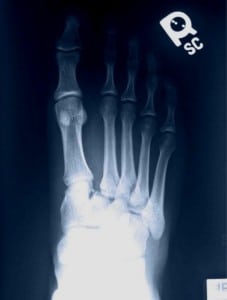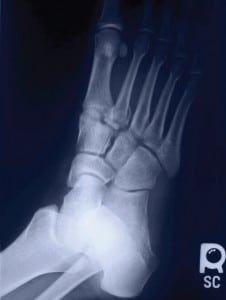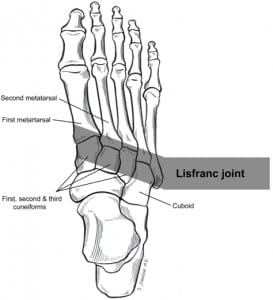| Author | Affiliation |
|---|---|
| Joel M. Schofer, MD | Department of Emergency Medicine, Naval Hospital Okinawa |
| Sean O’Brien, MD | Department of Emergency Medicine, Naval Hospital Okinawa |
Patient Presentation
A 22-year-old intoxicated male presented to the emergency department after jumping from a second-story window, landing on his right foot. He was able to ambulate with a great deal of pain across the dorsum of his foot. Physical examination revealed significant tenderness to palpation over the second metatarsal with minimal edema.
Final Diagnosis/Relevant Teaching Points
Radiographs of the foot reveal a fracture-dislocation of the tarsometatarsal or Lisfranc joint. A diastasis between the proximal 1st and 2nd metatarsals is seen and indicates an unstable injury (Figures 1 & 2). A bone fragment is present With thanks to Sonia Johnson, MD for her illustration of the Lisfranc joint. in this area due to an avulsion of the Lisfranc ligament. In addition, the lateral edge of the medial cuneiform does not align with the lateral aspect of the first metatarsal. This malalignment can be the only indication of injuries to the Lisfranc joint in more subtle presentations, which can easily be missed.



With thanks to Sonia Johnson, MD for her illustration of the Lisfranc joint.
Lisfranc fracture-dislocations are uncommon, but should be suspected in high-energy injuries, such as motor vehicle collisions and falls, as well as sports involving fixation of the forefoot (horseback riding, windsurfing). They can be caused by lower energy mechanisms, such as trips and falls.1 Any suspected Lisfranc fracture-dislocation requires orthopedic consultation as the treatment requires operative fixation.
Footnotes
Submission history: Submitted September 21, 2007; Accepted November 2, 2007.
Full text available through open access at http://escholarship.org/uc/uciem_westjem
Address for correspondence: Joel M. Schofer, MD, Department of Emergency Medicine, Naval Hospital Okinawa, PSC 482 Box 2827, FPO, AP 96362
Email: jschofer@gmail.com
Conflicts of Interest: By the WestJEM article submission agreement, all authors are required to disclose all affiliations, funding sources, and financial or management relationships that could be perceived as potential sources of bias. The authors disclosed none.
REFERENCES
1. Ho K, Abu-Laban RB. Ankle and foot. In: Marx JA, editor. Rosen’s Emergency Medicine: Concepts and Clinical Practice. 6. Philadelphia PA: Mosby Elsevier; 2006. pp. 828–829.


